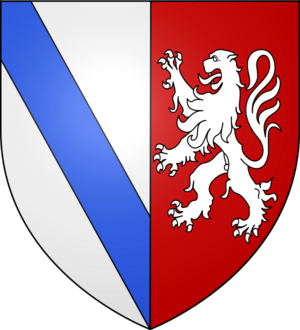Gaillard I de Durfort facts for kids
Gaillard I de Durfort (lived from about 1309 to 1356) was a French priest and a powerful nobleman. People called him the Archdeacon because of his church roles. He came from the important Durfort family.
In 1345, Gaillard inherited family lands. He then left his church job to marry Marguerite de Caumont. He was a key figure in the Hundred Years' War, a long conflict between England and France. He first fought for England, then for France, and then for England again.
Gaillard's Early Life and Church Career
Gaillard was born around 1299. His father was Arnaud, lord of Clermont and Lacour. His mother was Marquèse de Got. He had three brothers: Aimeric, Bertrand, and Raymond-Bernard.
Gaillard was very successful at getting many church jobs, called benefices. A benefice was a church position that came with an income. His mother's uncle was Pope Clement V, who was Pope from 1305 to 1314. Thanks to his uncle, Gaillard received many important roles.
He got three priories (places led by a prior) and three canonries (jobs for a canon, a type of priest). He also became an archdeacon in Orléans and Tours. An archdeacon was a senior church official. He got these jobs even before he was old enough or had become a full priest. Pope Clement V gave him special permission for this.
Later in life, Gaillard became a professor of canon law at the University of Toulouse. Canon law is the law of the church. He also held other church positions in places like Saintes, Agen, and York. He was also the cantor (leader of singing) at Cahors.
Gaillard made a lot of money from his church jobs, about 3,000 livres tournois (an old French currency) each year. Another Pope, John XXII, tried to fix some of the problems from Pope Clement V's time. So, in 1318, Pope John XXII made Gaillard give up one of his archdeacon roles.
We know about Gaillard's teaching from one surviving book. It's called "Reports given by the most excellent lord Gaillard of Durfort." This book contains lessons he taught at Toulouse around 1337 or 1338.
Fighting in the Hundred Years' War
The war between England and France began in 1337. Gaillard's older brother, Aimeric, fought for the French side. Because of this, Aimeric lost some of his lands to the English. However, he gained other lands from the French king. Aimeric was likely killed in a battle in 1345. Gaillard's other brother, Bernard, fought for the English.
In November 1345, Gaillard decided to leave his church career. He had only taken minor church vows. He became a knight, took over his brother's lands, and got married. Gaillard brought important castles like Puyguilhem and Duras to the English side. His remaining brothers and their followers also joined him.
He became the lord of several areas, including Lacour and Duras. He officially joined the English side in November 1345. In return, the English gave him back some lands they had taken and a large amount of money.
During the Gascon campaign of 1345 and the siege of Aiguillon in 1346, Gaillard defended the town of Bajamont against the French. He led many attacks against Agen, which was a French stronghold. He also raided along the Garonne river to stop supplies from reaching the French soldiers who were besieging Aiguillon.
In response, a French commander named Robert de Houdetot tried to besiege Bajamont. The French planned to surround Bajamont with earthworks. But on July 18, 1346, Gaillard ordered his soldiers to attack. They defeated the French and captured Houdetot.
After the sieges of Aiguillon and Bajamont ended, the English leader, the Earl of Derby, led a major raid into French territory in September 1346. He split his army into three groups. Gaillard led one group that raided the Agenais region.
After securing the Agenais, Gaillard led raids into another region called Quercy. He even reached the city of Cahors. With 400 horsemen, he raided north into the Corrèze region. He captured the market town of Tulle. This raid caused great fear in the province of Auvergne. The French army had to go to Tulle to besiege it from November to December. The Gascon soldiers defending Tulle surrendered and were taken prisoner. They were later set free after a ransom was paid.
Switching Sides in the War
On July 22, 1348, Gaillard received his last payment from the English. By 1352, the French were gaining power in Aquitaine. So, on May 3, 1352, Gaillard switched his loyalty to the French side. He signed an agreement with Carlos de la Cerda, a French military leader. His brother Bertrand and another relative also signed this agreement. The French King John II of France approved it in 1354.
For joining the French, Gaillard received a full pardon. He also got back his lands that French troops had taken. He received a large payment to help defend his castles and make up for money he lost from lands held by the English. His wife's family, the Caumonts, may have helped him get these good terms.
Gaillard changed his loyalty again in 1356. This happened after a big raid by Edward the Black Prince in 1355. On April 6, Gaillard signed an agreement with the English. It was similar to the one he had signed with the French four years earlier. King Edward III of England approved this agreement in 1358, but by then, Gaillard had already passed away.
Gaillard died sometime between April 4, 1356, and January 20, 1357. He was not at the Battle of Poitiers in September 1356. His son, Gaillard II, who was still young, took over his lordships.


